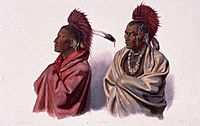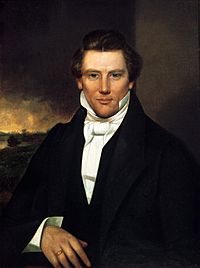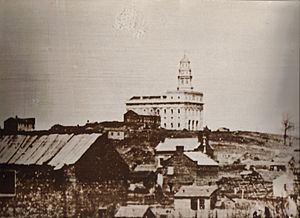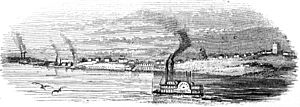History of Nauvoo, Illinois facts for kids
The history of Nauvoo, Illinois, starts with the Sauk and Fox tribes who frequented the area. They called the area "Quashquema", named in honor of the Native American chief who headed a Sauk and Fox settlement numbering nearly 500 lodges. Permanent settlement by non-natives was reportedly begun in 1824 by Captain James White. By 1827 other white settlers had built cabins in the area. By 1829 this area of Hancock County had grown sufficiently so that a post office was needed, and in 1832 the town, now called "Venus", was one of the contenders for the new county seat. However, the nearby city of Carthage was selected instead. In 1834 the name Venus was changed to "Commerce" because the settlers felt that the new name better suited their plans. In late 1839, arriving Mormons bought the small town of Commerce, and in April 1840 it was renamed "Nauvoo" (a Hebrew word meaning "they are beautiful") by Joseph Smith, the latter day prophet of the Latter Day Saint movement. Nauvoo grew rapidly and for a few years was one of the most populous cities in Illinois. Within two years of Joseph Smith's death in 1844, most of the population had departed, fleeing armed violence. Most headed west with the group led by Brigham Young.
In 1849 Icarians moved to the Nauvoo area to implement a utopian socialist commune. In the early and mid 20th century Nauvoo was primarily a Catholic town, and the majority of the population today is Catholic. Nauvoo today is an important tourist destination for Latter Day Saints (Mormons) and others who come to see its restored historical buildings and visitor centers.
Contents
Sauk and Meskwaki
A large village of Sauk and Meskwaki lived along the Mississippi near what is Nauvoo, established in the late 18th century; this village had as many as 1,000 lodges. In 1823 or 1824, Captain James White purchased the village from Quashquame, a Sauk leader. White gave Quashquame “a little sku-ti-apo [liquor], and two thousand bushels of corn” for the land. Quashquame's village moved to the west side of the river, merging with an existing Sauk village near what is now Montrose, Iowa.
In 1841, Joseph Smith, Jr., living in Nauvoo, was visited by Sauk and Meskwaki from the Iowa village. "The ferryman brought over a great number on the ferry-boat and two flat boats for the purpose of visiting me. The military band and a detachment of Invincibles (part of the Legion) were on shore ready to receive and escort them to the grove, but they refused to come on shore until I went down. I accordingly went down, and met Keokuk, Kis-ku-kosh, Appenoose, and about one hundred chiefs and braves of those tribes, with their families." Smith then discussed the Mormon religion with them, followed by a feast and dancing by the Indians.
Nauvoo founded by the Latter Day Saints
In early 1839, Latter Day Saints were forced to flee Missouri as a result of the 1838 Mormon War and a legal proclamation known as Missouri Executive Order 44 issued by Governor Lilburn W. Boggs. They regrouped in Quincy, whose non-Mormon citizens were shocked by the harsh treatment given them in Missouri and opened their homes to the refugees.
Joseph Smith, Jr., Prophet and president of the Church of Jesus Christ of Latter Day Saints, remained imprisoned in Missouri, but his chief counselor in the First Presidency, Sidney Rigdon, had been released and rejoined the main body of the church in Quincy. Church member Israel Barlow fled Missouri and entered Illinois further north than the main group of Latter-day Saints. Learning from Isaac Galland, a land agent, that a large amount of land was for sale in the Commerce area, he contacted church leaders. Galland approached Rigdon in Quincy, Illinois and offered church leaders title to land in Hancock County and additional land across the river in the Iowa Territory's Lee County. Church leaders purchased this land as well as the mostly vacant Commerce plat in 1839, and Latter Day Saints began to settle the area immediately.
Physically weak from months of imprisonment, Smith and other leaders were permitted to escape from prison in Missouri. They rejoined the Latter Day Saints in Commerce by May 1839. He renamed the town "Nauvoo", meaning "to be beautiful." Latter Day Saints often referred to Nauvoo as "the city beautiful," or "the city of Joseph."
Despite the name, the site was, at first, an undeveloped swamp. Epidemics of cholera, malaria and typhoid took their toll on the struggling Mormons until the swamp was drained. The smaller community of Commerce had few buildings so construction began promptly to meet the immediate demand for housing. Elements of Joseph Smith's generalized city plan, known as the "plat of Zion" (first introduced in 1833) were used in the street layout and lot allotments in Nauvoo. The community was characterized by wood frame homes with outbuildings, gardens, orchards and grazing plots on large lots laid out on an orderly grid system. In general, the buildings were detached single-family dwellings reminiscent of New England construction styles with commercial and industrial buildings in the same pattern.
Building up the city
In the spring of 1840, John C. Bennett, the Quarter Master General of the Illinois State Militia converted to Mormonism and became Joseph Smith's friend and confidante. Bennett's experience with Illinois' government allowed him to help Smith craft a city charter for Nauvoo Based closely on the Springfield, Illinois, charter, the document gave the city a number of important powers, including the establishment of Municipal Court of Nauvoo, the University of Nauvoo, and an independent militia unit. At the time, the Illinois state government was closely balanced between members of the Democratic party and members of the Whig party. Both hoped to attract Mormon votes and both were quick to place the charter into effect. After the charter was passed, Bennett was elected Nauvoo's first mayor and Smith made Bennett a member of the church's First Presidency. A militia unit, named the "Nauvoo Legion" was established, and Smith and Bennett were made its commanding generals.
The city grew quickly as Mormons gathered. At its height Nauvoo's population was as large as Quincy's or Springfield's, although it remained smaller than contemporary Chicago. Many new residents came from the British Isles, as a result of a successful LDS mission established there. The Latter Day Saints published two newspapers in the city, the religious and church-owned Times and Seasons and the secular and independently-owned Wasp (later replaced by the Nauvoo Neighbor). Although it mostly existed on paper, the University of Nauvoo was established, with Bennett as chancellor.
The Nauvoo Legion, a militia, with 2,000 men was headed by the Prophet Joseph Smith who was given the commission of Lieutenant-general by Illinois' Governor Carlin. The Nauvoo militia consisted of a corps of riflemen.
On April 6, 1841, the Nauvoo Legion drilled in a great parade to honor the laying of the cornerstone for a new temple and Sidney Rigdon gave the dedicatory speech. The foundation of the Nauvoo Temple was 83 ft (25 m) by 128 ft (39 m) and, when finished, its steeple rose to a height of over 100 ft (30 m). Church elder Alpheus Cutler was put in charge of the construction of the ambitious stone structure. Another church committee began construction of a large hotel on the city's Water Street, to be called the Nauvoo House. John D. Lee was put in charge of constructing a meeting hall for the quorums of the Seventies.
In October 1841, a Masonic Lodge was established in Nauvoo in the building currently referred to as the Cultural Hall. George Miller, one of the church's bishops, was made its "Worshipful Master" or leader. The lodge admitted far more members than was normal in Masonic practice and quickly elevated church leaders to high roles. This was the most significant time in which the Latter Day Saints were involved in Masonry.
Developments in the church
At the time of Nauvoo's foundation, the church was led by a First Presidency, consisting of a Prophet and two Counselors. The Presiding High Council (known as the Nauvoo High Council), led by Nauvoo Stake President William Marks was next in administrative authority, overseeing the church's legislative and judicial affairs. The church's "Traveling High Council" (or Quorum of the Twelve) led by President Brigham Young oversaw the church's missionary activities.
After the First Presidency and Mayor, John C. Bennett, was expelled from Nauvoo in the summer of 1842, Smith became the city's second mayor. Smith ran for President of the United States in 1844.
Growing hostility towards Mormons
As Mormon population grew, non-Mormons in Hancock County, especially in the towns of Warsaw and Carthage, felt threatened by the political power of the growing Mormon bloc-voting. In Nauvoo, Joseph Smith, Jr. was not only President of the Church, he was Mayor, head of the municipal court, and general of the militia. This power base, plus the fact that Mormons benefited from collective group efforts as opposed to the more isolated and independent non-Mormon farmer, caused many non-LDS in the nearby areas to become suspicious and jealous.
Throughout much of the Nauvoo period, officials from Missouri attempted to arrest Smith and extradite him on charges relating to the 1838 Mormon War. When he was apprehended, Smith would appeal to the Nauvoo Municipal Court, which would issue writs of habeas corpus and force his release.
In 1844, First Presidency member, William Law — an important merchant and counselor to Smith — broke with the church president over both the issue of plural marriage and the legal issues in Nauvoo. Law was excommunicated and founded a reformed church called the True Church of Jesus Christ of Latter Day Saints. He also established a newspaper named the Nauvoo Expositor; only one issue was published.
On June 10, Smith held a meeting of the city council which, after two full days of meeting, condemned the Expositor as "a public nuisance" and empowered him to order the press destroyed. A portion of the Nauvoo Legion, Smith's militia, marched into the office, wrecked the press and burned every copy of the Nauvoo Expositor that could be found.
The destruction of the press was seen as an opportunity by critics such as Thomas Sharp, whose paper in nearby Warsaw had been openly calling for destruction of the Church. Fanned by Sharp and others, public sentiment held that the action was illegal and unconstitutional. Some non-Mormons and disaffected church members in and around Hancock county, Illinois, began to call for Smith's arrest. Smith, his brother Hyrum, and several other church leaders submitted to arrest. While awaiting trial in Carthage, the county seat, under assurance of safety from Illinois governor Ford, Joseph and Hyrum Smith were assassinated when a vigilante mob attacked the jail.
The "Mormon War in Illinois" and the Mormon Exodus
Quick facts for kids Illinois Mormon War |
|||||||
|---|---|---|---|---|---|---|---|
| Part of the Mormon wars | |||||||
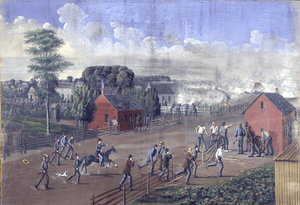 Depiction of the Battle of Nauvoo, by C.C.A. Christensen |
|||||||
|
|||||||
| Belligerents | |||||||
| Nauvoo Legion | |||||||
| Commanders and leaders | |||||||
Thomas Brockman |
Joseph Smith† Brigham Young Hosea Stout Daniel H. Wells |
||||||
| Strength | |||||||
| About 1,000 | Less than 150 | ||||||
| Casualties and losses | |||||||
| Unknown number wounded | About ten killed, unknown number wounded | ||||||
After Smith's assassination, the agitation against Mormons continued. The conflict escalated into what has sometimes been called the "Mormon War in Illinois." Opponents of the Mormons in Warsaw and Carthage began to agitate for the expulsion from Illinois of the Latter Day Saints. In October 1844, a great gathering was announced in Warsaw. Although it was purported to be a "wolf hunt," it was known that the "wolves" to be hunted were the Mormons. When Governor Thomas Ford became aware of it, he sent militia troops to disperse the gathering. However, as he later recalled:
- "The malcontents abandoned their design, and all the leaders of it fled to Missouri. The Carthage Greys fled almost in a body, carrying their arms along with them. During our stay in the county the anti-Mormons thronged into the camp and conversed freely with the men, who were fast infected with their prejudices, and it was impossible to get any of the officers to aid in expelling them".
Vigilante bands continued to roam the county, forcing Latter Day Saints in outlying areas to abandon their homes and gather in Nauvoo for protection.
When the Illinois state legislature met in December 1844, there was great support for the repeal of the Nauvoo Charter. Governor Ford conceded that the charter's privileges had been "much abused" by the Mormons, but he urged that the legislature merely amend the document, saying "I do not see how ten or twelve thousand people can do well in a city without some chartered privileges". However, on January 29, 1845, the repeal was overwhelmingly passed by a vote of 25-14 in the Senate and 75-31 in the House.
After its legal disincorporation, Nauvoo government and civil institutions were legally dissolved and the church administrative structure operated as a default government. This more theocratic organization was known informally by its residents as the "City of Joseph" while disincorporated.
Nauvoo's population peaked at about this time in 1845; it may have had as many as 12,000 inhabitants (and several nearly as large suburbs) — rivaling Chicago, whose 1845 population was about 15,000.
On September 10, 1846, a mob of about 1,000 anti-Mormons besieged Nauvoo. Three of the less than 150 Mormon defenders were killed, and skirmishing left wounded on both sides. About a week later, on September 16, Daniel H. Wells and the Mormon leadership of Nauvoo surrendered to the mob and arranged for their people's evacuation from the town and expulsion across the Mississippi River into the Iowa Territory. After the departure of the Mormons, the temple stood until destroyed by arsonists on November 19, 1848. On April 3rd, 1999, plans were announced to rebuild the temple on the historic site where it once stood. LDS church leaders broke ground for the new temple on October 24th, 1999. After construction was completed, the new temple was dedicated for use by members of the LDS church on June 27th, 2002.
159 years later, on April 1, 2004, the Illinois House of Representatives unanimously passed a resolution of regret for the forced expulsion of the Mormons from Nauvoo in 1846.
Subsequent history
Emma Hale Smith, Joseph's widow, continued to live in Nauvoo with her family after the departure of the majority of the Latter Day Saints. In 1860, their son, Joseph Smith III, claimed to receive a revelation to take his place as Prophet/President of a group known as the Reorganized Church of Jesus Christ of Latter Day Saints. He continued to live in Nauvoo, which functioned as headquarters of this church (now known as the Community of Christ) until 1865. In 1866, Smith moved from Nauvoo to Plano, Illinois, where the church's printing house had been established. He personally took over the editorship of the Saint's Herald, and Plano became the headquarters of the church. In his final years, members of the church began to move to Independence, Missouri, which Smith's father had designated as the "center place" of the "City of Zion." Latter Day Saints had wanted to return to this theologically important ground since their expulsion in 1833.
Icarians
In 1849, Icarians moved to the Nauvoo area to implement a utopian socialist commune based on the ideals of French philosopher Étienne Cabet. At its peak, the colony numbered over 500 members, but dissension over legal matters and the death of Cabet in 1856 caused some members to leave this parent colony and move on to other Icarian locations in East St. Louis, Illinois, and Iowa and California. Descendants of this Icarian colony still live in Hancock and McDonough counties. The Icarian historical collection is located at the Western Illinois University library in Macomb.
Catholic history
In the early and mid 20th century Nauvoo was primarily a Catholic town, and the majority of the population today is Catholic.
On October 15, 1874 Sister Ottilia Hoeveler, and four other sisters came from St. Scholastica Convent in Chicago to start a girls school. Originally named St. Scholastica Academy it opened on November 2, 1874. Seven girls from Nauvoo and the vicinity were enrolled.
In 1879 the convent became independent of Chicago and the name of the school was changed to St. Mary's Academy and the convent became St. Mary's Convent. The convent was expanded in 1892 and a new school building built in 1897.
In 1907 a boys school, Spalding Institute, was built. Spalding did not last long and closed in 1920. In 1925 it was reopened as a new boys school named St. Edmund's Hall. This school closed in 1940 and the building was used as the new convent named Benet Hall.
In the 1950s and 1960s many new buildings were built: Monastery (1954), High School (1957), Dormitory (1967). Enrollment fluctuated after the 1960s. Due to declining enrollment St. Mary's Academy closed in June 1997.
St. Mary's was sold and used as the Joseph Smith Academy until the winter semester of 2006 and began to be torn down in September 2007.
Sts. Peter and Paul Elementary continues to provide education for grades PK-6.
Images for kids


